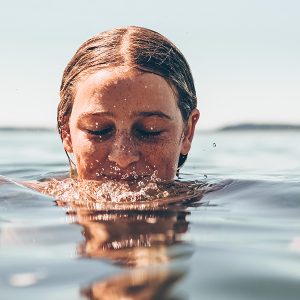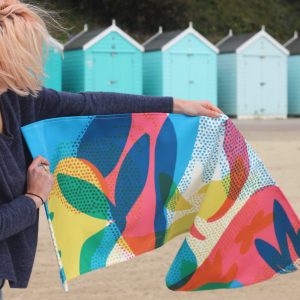You can see them in groups in lakes, ponds and rivers: ‘wild swimmers’ gliding smoothly and calmly through the water. Not only in the summer, but also on chilly and wintry days. It exudes a sense of freedom and bravery that is contagious. As you watch them rhythmically making their way through the cool water stroke by stroke, you can almost feel the refreshment it brings them.
Mind Sport
Scientific research has shown that swimming in open water is good for both your physical and mental health. It has a positive effect on your mood and can even help lift depression, says Greg Whyte, professor of applied sport and exercise science at Liverpool John Moores University, UK, and a former Olympic pentathlon athlete. Part of the explanation is that in cold, natural water your body produces higher doses of dopamine, also known as the ‘happy hormone’. What’s more, it’s a social activity, because swimming solo outdoors, in a lake or river, is not the best of ideas. You can join an existing swimming club or form one yourself.
Enjoyment
“It’s really great, because others can help you with tips and techniques, and swimming in a group increases your enjoyment,” Whyte says. “It builds confidence to feel comfortable in the water. Sometimes you notice that this also makes you more confident in your everyday life.” Another nice fringe benefit: Open water swimming is not aimed at speed or performance, but is all about the experience itself.
“Personal speed records per set distance are not important,” says Whyte. In fact, you usually don’t even know what distance you’re swimming. After all, unlike in a swimming pool, open water is not divided into clear courses, and there are no clocks to be seen anywhere.”
Ritual movements
Something else we are also seeing more and more often is people standing in the shallow part of a lake (or swimming pool) while they appear to be making some kind of ritual movements. It looks a bit like tai chi, but it’s actually swimming exercises. It’s part of the Shaw Method, which was founded by Steven Shaw and applies the principles of the Alexander Technique to swimming.
It focuses on smoother, more natural, healthier and more attentive swimming—with variations of traditional swimming strokes. Once they have completed their ritualistic preparations, you can see these swimmers moving through the water very smoothly and coming back to land peaceful and refreshed. As if they have done nothing but relax. Or maybe even as if they’ve been meditating.
According to Esther Visser, who teaches the method, this way of swimming is more of a mind sport than a physical sport. “You do each individual phase of the swimming stroke with very focused attention, to maximize the quality of your movement,” she says. “This means you don’t have time to think about what’s going on at work or what you’re going to have for dinner. That makes these techniques very mindful. Afterward, you often feel not only mentally refreshed, but it also feels as if you’ve had a massage instead of a workout.”
Glorious Day
Kate Rew is a co-founder of the Outdoor Swimming Society (OSS), a club that now has almost 100,000 members across its channels, and author of the book Wild Swim, which features great places in the UK for outdoor swimming. “I think the growing popularity of open water swimming all year round has to do with the current zeitgeist,” she says.
“We are all looking for simple and pure experiences; for experiences that are real, earthy and completely our own. And with no commercial angles, because that doesn’t add anything. In my opinion, swimming gives the most intense pleasure and the deepest satisfaction when you do it in the wild, simply jumping into a river or lake somewhere.
The effect that wild swimming has on your mind and mood is fantastic. You feel better after a refreshing dip; it makes your day more glorious. Nearly everyone who starts doing this becomes almost evangelical in their zeal to tell others how nice it is to swim wild. Maybe that’s why it’s such a rapidly growing phenomenon.”
Technique
“People would rather invest in an experience or skill, in personal development than in more material possessions,” Visser says. “We organize wild swimming courses in a beautiful lake in the dunes near Haarlem, the Netherlands.
With the tranquility of nature and the wonderful sea air to breathe, you can focus fully on your technique. Your mind hones in on things like: ‘How do I pull my hand through the water? How does the water feel? Do I really have a grip on it? Can I relax my muscles?’ All your thoughts about home and work disappear from your mind.”
Swimming together
The OSS organizes a Mindful Mile wild swimming course run by OSS Swim Champion Katie Maggs every year in the UK. “Many participants have not swum outdoors for years or never even dreamed that they would swim a mile in open water,” Maggs says.
“The Mindful Mile is not about a competition, nor how hip your swimwear is or how well or fast you swim. People of all ages and ability levels come together to swim in beautiful surroundings. This creates a connection; there is mutual support and encouragement, it’s fun, it’s peaceful and it contributes to a feeling of pride and strength.”
Singing Under Water
Besides being a teacher of the Shaw Method, Visser is also a concert violinist and Alexander Technique teacher—and that combination is no coincidence. “At the conservatory, I often walked past one little room where I noticed musicians almost always had a smile on their face, and their posture seemed to be more supple. It piqued my curiosity. It turned out that someone in that room was teaching the Alexander Technique. I took a trial lesson with simple movement exercises. The next time that I picked up my violin, my playing suddenly sounded three times better. It was almost magical.
Alexander Technique
The Alexander Technique teaches you to consciously control your movements with your thoughts, in order to prevent injuries and improve your performance. I decided to take weekly classes. Later, when I had become a concert violinist, I trained to become a teacher in the Alexander Technique. Not much later, I found out about Steven Shaw, a British swimmer and Alexander Technique teacher. After having to give up his swimming career due to an injury, he made modifications to the four Olympic swimming strokes based on the Alexander Technique.
I went to take courses with him in London, UK, did the teacher training and gained exclusive rights to introduce the Shaw Method in the Netherlands, where it meets a great need. People who come to us don’t always realize in advance that we don’t give standard swimming lessons—but luckily they always become enthusiastic.
Often they’re surprised that they never learned some of these fairly simple techniques before. Slowly breathing out underwater, for example. We teach them that by singing underwater.”
Away From Your Worries
Just as with the OSS, the lessons Visser gives at her Swim in Balance courses are not performance-oriented. “Although you do end up swimming faster than before, the Alexander Technique is not only about learning an attitude or technique, but also about what you’re thinking through the duration of a movement,” Visser says.
“In our swimming lessons, we teach people to think the right things at every stage of the swimming stroke. So it is a very attentive way of swimming that requires practice. Over six weeks, you will be taught a swimming stroke step by step, on dry land and then in the water, until you finally master the complete stroke with all the physical and mental movements that go with it.
Think
Sometimes people think that the ultimate goal is for the swimming stroke to be carried out without any thought. But I’m trying to teach them not to pursue that at all. If you go swimming on autopilot, your technique will get progressively worse and your anxious thoughts will return. It is much more fun and interesting to think, even when you’ve gotten quite good, ‘Can I relax my arms even more? Can the movement be even smoother?’
You will notice more and more small details that you can improve. That is the art of it. It is just like playing the violin: there will never be a moment when you can say, ‘There, now I’m done’. You can always refine, deepen and enrich your playing.”
Rew describes it like this: “I love perfecting the art of swimming, although I still have a long way to go. I love that swimming makes you feel alert and calm at the same time. The introverted person in me loves the silence of being outdoors, the way modern life just slides off of you. All of your deadlines and concerns that arise from your social life become completely irrelevant. The only thing that matters is you are swimming.”
Varied group
Rew says you often read stories in the media about people in their 30s, 40s and 50s who discover swimming as a way to get rid of stress and problems. “But in reality,” she says, “the group that joins us is quite varied, ranging from teenagers all the way to swimmers in their 80s.” Visser also sees people from all age groups joining in. “One person may be preparing for a triathlon,” she says, “another sees swimming as an ideal sport that you can do when it suits you—and someone else is doing it just to stay fit.”
Butterfly Stroke
The nice thing is she doesn’t have to make separate groups for beginners and experienced swimmers, because it doesn’t matter if you are built athletically, how old you are or any of that. “Last year, a 72-year-old lady came along to our annual swimming vacation in Croatia,” Visser says. “She wanted to learn the butterfly stroke; she had never done it before. Step by step, she mastered it, very gracefully. You don’t have to be strong for our techniques. There were some young muscular Croatians next to us who were also swimming the butterfly stroke. They did everything very powerfully but weren’t getting very far.
Apparently they didn’t know that in certain stages of the stroke you shouldn’t use power but that, on the contrary, you should relax your muscles. If you move your legs upward with force, you’re pulling yourself backward and working against yourself. You should only use your muscles on the downward movement. The Croatians saw the older lady getting better and better every day, and even overtaking them. So they ended up asking if they could also take lessons.”
“That’s another one of the great things about swimming: There is this special kind of honesty,” Rew says. “As swimmers, you often understand each other very quickly, and before you know it you’re having really nice conversations. Besides peace, freedom, joy and adventure, swimming has brought me many friends.”
Want to know more?
- Wild Swim: River, Lake, Lido and Sea: The Best Places to Swim Outdoors in Britain, by Kate Rew
- Master the Art of Swimming: Raise Your Performance with the Alexander Technique, by Steven Shaw
- Leap In: A Woman, Some Waves, and the Will to Swim, by Alexandra Heminsley
- Outdoorswimmingsociety.com
Text Chris Muyres Photography Erik Dungan/Unsplash.com













